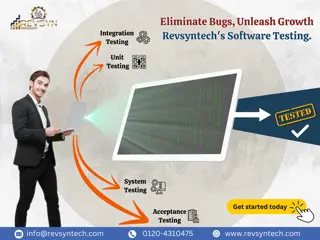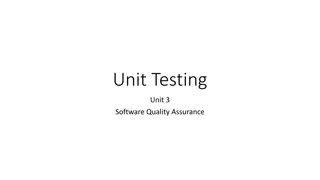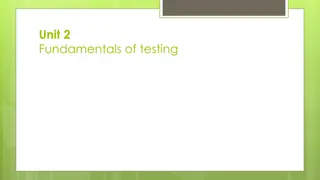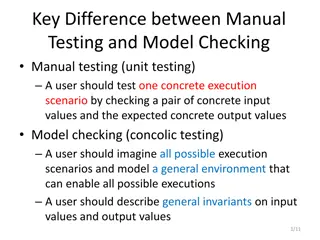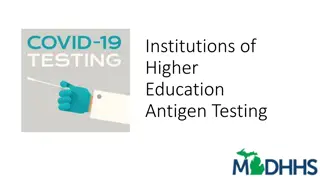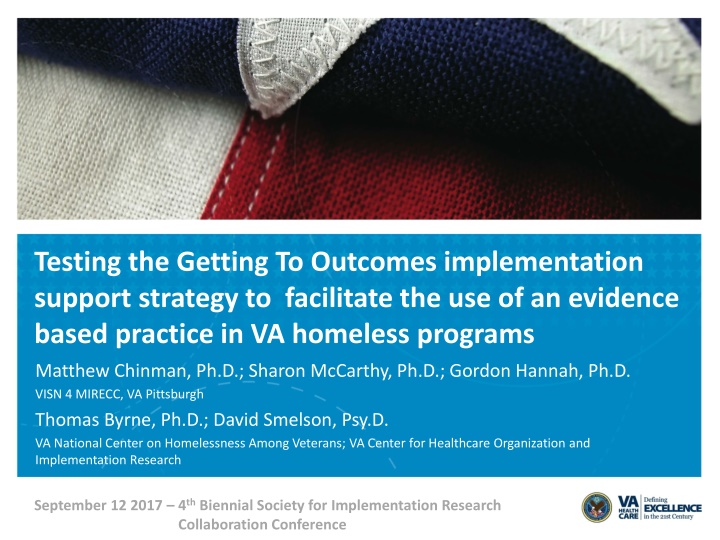
Supporting Evidence-Based Practice in VA Homeless Programs with GTO Implementation
Learn how the Getting to Outcomes (GTO) implementation support strategy is aiding evidence-based practice in VA homeless programs. Discover the impact on reducing homelessness among veterans and improving integrated care for co-occurring substance and mental health disorders.
Uploaded on | 0 Views
Download Presentation

Please find below an Image/Link to download the presentation.
The content on the website is provided AS IS for your information and personal use only. It may not be sold, licensed, or shared on other websites without obtaining consent from the author. If you encounter any issues during the download, it is possible that the publisher has removed the file from their server.
You are allowed to download the files provided on this website for personal or commercial use, subject to the condition that they are used lawfully. All files are the property of their respective owners.
The content on the website is provided AS IS for your information and personal use only. It may not be sold, licensed, or shared on other websites without obtaining consent from the author.
E N D
Presentation Transcript
Testing the Getting To Outcomes implementation support strategy to facilitate the use of an evidence based practice in VA homeless programs Matthew Chinman, Ph.D.; Sharon McCarthy, Ph.D.; Gordon Hannah, Ph.D. VISN 4 MIRECC, VA Pittsburgh Thomas Byrne, Ph.D.; David Smelson, Psy.D. VA National Center on Homelessness Among Veterans; VA Center for Healthcare Organization and Implementation Research September 12 2017 4th Biennial Society for Implementation Research Collaboration Conference
Homeless Veterans VA efforts to combat homelessness among Veterans has drastically reduced the number of homeless Veterans About 80% of the remaining 48,000 Veterans who are homeless have co-occurring substance and mental health disorders: integrated care is most effective
Compare GTO to Implementation as Usual in real world of HUD-VASH MISSION- Vet + GTO (DC, Northampton, Denver) N=37 MISSION- Vet (DC, Northampton, Denver) N=22 VS. AIM One: MISSION fidelity Track MISSION services delivered AIM Two: Housing outcomes - HOMES (CM report) AIM Three: Mental health, substance use and functional outcomes - HOMES (CM report) AIM Four: Track factors key to the successful deployment of MISSION-Vet CFIR based interviews and ratings Department of Veterans Affairs (Mental Health QUERI): MISSION-Vet HUD-VASH Implementation Study (SDP 11-235). Smelson, PI, Chinman, Co-PI; 1/31/12-6/30/16.
MISSION Vet: Maintaining Independence and Sobriety through Systems Integration, Outreach and Networking: Veterans Edition An integrated treatment for Veterans with SA Case managers and Peer Specialists work with Veteran about 2.5 hours/week for 1 year Comprehensive, manualized patient and clinician tools Free web based materials and trainings
HUD VASH: Housing and Urban Development VA Supportive Housing Provides subsidized housing from HUD Case management provided by the VA The goal to end Veteran homelessness and Housing First approach has strained resources, especially staff Primary goal to provide and sustain housing During study, caseloads increased in size and acuity
GTO model supports high quality program implementation 3 4 Find existing programs and best practices worth copying. Modify the program or best practices to fit your needs. 5 2 Identify goals, target population, and desired outcomes. Assess capacity (staff, financing, etc.) to implement the program. Steps 1-6 PLANNING 6 1 Make a plan for getting started: who, what, when, where, and how. Choose which problem(s) to focus on. DELIVERING PROGRAMS Steps 7-10 EVALUATING AND IMPROVING 7 10 Evaluate planning and implementation. How did it go? Consider how to keep the program going if it is successful. 8 9 Evaluate program s success in achieving desired results. Make a plan for Continuous Quality Improvement.
GTO uses multiple implementation strategies to build capacity GTO Components 4 3 Modify the program or best practices to fit your needs. Find existing programs and best practices worth copying. 5 2 Technical Assistance Manual Identify goals, target population, and desired outcomes. Assess capacity (staff, financing, etc.) to implement the program. Steps 1-6 PLANNING 6 1 DELIVERING PROGRAMS Make a plan for getting started: who, what, when, where, and how. Choose which problem(s) to focus on. Steps 7-10 EVALUATING AND IMPROVING 7 1 0 Evaluate planning and implementation. How did it go? Consider how to keep the program going if it is successful. 8 9 Evaluate program s success in achieving desired results. Make a plan for Continuous Quality Improvement. Training
Adapted GTO to fit HUD-VASH reality GTO Components Bi-weekly meetings for 18-23 months What is your goal? (e.g., house Vets) Technical Assistance Manual What will you do ? (e.g., MISSION-Vet) How will you fit it into HV? What is your plan? (e.g., How many will you serve with MISSION?) Training How was implementation? Did you reach your goal? What should change to reach goal? Full day on GTO
Case Managers in GTO group tried MISSION; IU group did no MISSION GTO Group Imp as Usual Group 0 % Tried MISSION % Tried MISSION 32 % Did not try MISSION % Did not try MISSION 68 100 8
Case Managers in GTO group delivered MISSION with few Veterans % of Caseload Receiving MISSION 100 90 80 70 60 50 40 30 20 10 0 % received any MISSION % received 10% MISSION % received 25% MISSION % received 50% MISSION 9
Case Managers in GTO group delivered MISSION with low fidelity Implementation of MISSION 100 90 80 70 60 50 40 30 20 10 0 % received workbook % DRT sessions received % Peer sessions received 10
Veteran level outcomes show slight signal for MISSION Compared 87 Vets from GTO group with comparison group from IU group on housing status, employment status, service intensity, drug/alcohol dependence, inpatient hospitalizations, emergency department visits Vets receiving MISSION got about 2 more contacts per month than comparison Vets No other outcomes were significant A subgroup of higher intensity MISSION trended positively (favoring GTO/MISSION) on alcohol use, drug use, mental health hospitalization, and probability of medical hospitalization and medical ER use
Case Managers in GTO group faced many challenges CFIR Constructs Team 1 Team 2 Team 3 Intervention Characteristics Intervention source Evidence strength Relative advantage Adaptability Complexity Design quality Inner Setting Networks and communications Compatibility Relative priority Org. incentives and rewards Goals and feedback Leadership engagement Available resources Access to knowledge and info Outer Setting Patient needs and resources Cosmopolitan Process Planning Engaging key stakeholders Engaging Veterans -1 0 +1 +2 -1 0 -1 0 +1 +2 0 -1 -1 0 +1 +2 -1 0 -2 -1 -2 -1 0 -1 -1 -1 +1 -2 -2 0 0 +1 -1 0 -1 -1 -2 -1 -1 -1 +1 +1 +1 0 +1 0 +1 +1 +1 +1 -1 +1 0 -2 +1 +1 -1
GTO was able to facilitate some MISSION, but challenges were great Sites valued MISSION and used it for certain cases that were high need; GTO planning and TA support was key Control group showed what happens with no support Using MISSION across whole caseload unrealistic New housing initiative (more Vets with more problems) made new initiatives difficult Organizational barriers and a lack of leadership support hurt implementation
Translating Research into Practice Practice/Policy implications for my setting/stakeholders (context-specific) MISSION could be a good fit for care structures that can devote more time per Veteran MISSION guidance valued Facilitated care that taps into why case managers first decided to serve Demonstrates need for readiness at site Among leaders to support innovation Among clinical providers to try something new Practice/Policy implications beyond my setting/stakeholders (Generalizable) Demonstrates that policy memos or other edicts from a central authority (VA central office), by themselves, have little impact Demonstrates that one time trainings attended by clinical providers have no impact; continued follow up from facilitation is needed
Questions? Matthew Chinman, PhD VA Pittsburgh Healthcare System Research Office Building (151R) University Drive C Pittsburgh, PA 15240 412 360-2438 chinman@rand.org 15

